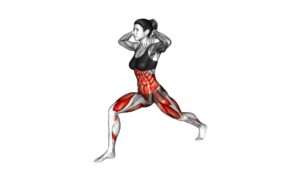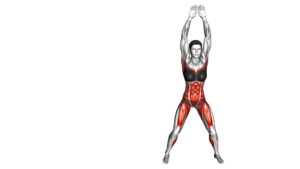Side Split (female) – Video Exercise Guide & Tips

Are you looking to improve your flexibility and master the side split? Look no further!
Watch This Exercise Video
This video exercise guide is here to help you achieve your goals. With proper form and technique, along with warm-up and stretching recommendations, you'll be on your way to mastering this challenging exercise.
Whether you're a beginner or looking to increase your flexibility, this guide is packed with tips and modifications to suit your needs.
Get ready to stretch, strengthen, and achieve that impressive side split!
Key Takeaways
- Side split exercises improve hip mobility and overall flexibility.
- Proper form and technique are important to prevent injuries and achieve better results.
- Warm-up and stretching before the exercise reduce the risk of strains or sprains.
- Beginners can use modifications like using a support and gradually increasing depth to ease into the side split position.
Benefits of Side Split Exercise
To maximize the effectiveness of your side split exercise, it's important to understand the benefits that it offers. Not only does the side split exercise help to improve hip mobility, but it also plays a crucial role in preventing injuries. By regularly incorporating this exercise into your fitness routine, you can experience significant improvements in your overall flexibility and range of motion.
One of the key benefits of the side split exercise is its ability to improve hip mobility. As you perform the exercise, you're actively stretching the muscles and ligaments in your hips, allowing for greater flexibility and range of motion. This can be especially beneficial for athletes and individuals who participate in activities that require a wide range of hip movement, such as martial arts or dancing.
Additionally, the side split exercise is an effective way to prevent injuries. By regularly stretching and strengthening the muscles in your hips, you can reduce the risk of strains, sprains, and other hip-related injuries. This is particularly important for individuals who engage in high-impact activities or have a history of hip problems.
Proper Form and Technique
Maintain proper form and technique to maximize the benefits of the side split exercise and prevent injuries.
When performing the side split, it's important to avoid common mistakes that can hinder your progress and lead to common injuries.
One common mistake is forcing yourself into the split position without proper warm-up and preparation. This can strain your muscles and increase the risk of pulling or tearing them.
Another mistake isn't engaging your core and pelvic muscles during the exercise. By neglecting this, you not only miss out on the full benefits of the exercise but also put unnecessary strain on your joints and ligaments.
It's also crucial to avoid leaning forward or backward during the side split, as this can compromise your alignment and increase the risk of injury. To ensure proper form and technique, remember to keep your back straight, shoulders relaxed, and feet flexed.
By maintaining proper form and technique, you won't only achieve better results but also reduce the likelihood of injuries.
Now that you understand the importance of proper form and technique, let's move on to warm-up and stretching recommendations to further enhance your side split practice.
Warm-Up and Stretching Recommendations
Before you begin your side split exercise, it's important to properly warm up and stretch to prevent injuries and enhance your performance. Warm-up exercises help increase blood flow to your muscles, prepare your body for the workout, and reduce the risk of strains or sprains. Dynamic stretches are a great way to warm up as they involve active movements that mimic the actions you'll perform during the side split exercise. These stretches help improve flexibility, increase range of motion, and activate the muscles you'll be using.
When performing dynamic stretches, make sure to maintain proper form throughout. This means keeping your spine aligned, engaging your core muscles, and avoiding any jerky or sudden movements. By maintaining proper form, you reduce the risk of injury and ensure that you're targeting the correct muscles.
In addition to warm-up exercises, it's crucial to include stretching in your routine. Stretching helps lengthen the muscles and improve flexibility, making it easier to achieve the side split position. Focus on stretching the muscles of your inner thighs, hips, and lower back, as these are the primary muscles involved in the side split.
Modifications for Beginners
If you're new to the side split exercise, there are some modifications that can help you ease into the movement and build up your strength and flexibility. As a beginner, it's important to start slowly and listen to your body.
One modification you can try is to use a support such as a chair or a wall. Place your hands on the support and gradually lower yourself into the side split position. This will help you maintain balance and stability as you work on improving your flexibility.
Another modification for beginners is to decrease the range of motion. Instead of going all the way down into a full side split, start by going only as far as is comfortable for you. As you gain strength and flexibility, you can gradually increase the depth of your split.
Common mistakes to avoid when doing the side split as a beginner include forcing yourself into the position and not warming up properly. Remember to warm up your muscles before attempting the exercise, and never push yourself beyond your limits. It's important to listen to your body and only go as far as feels comfortable.
Tips for Increasing Flexibility
To increase flexibility for the side split exercise, focus on gradually stretching your muscles and improving your range of motion. Incorporating certain yoga poses and foam rolling into your routine can help you achieve this goal.
Yoga poses such as the Butterfly Pose, Wide-Legged Forward Bend, and the Lizard Pose can specifically target the muscles needed for the side split. These poses not only stretch the inner thighs and hamstrings but also engage the core and improve overall flexibility.
Foam rolling is another effective technique to increase flexibility. By using a foam roller, you can release tension in your muscles and improve blood circulation, which aids in muscle recovery and flexibility. Focus on rolling your inner thighs, hamstrings, and glutes to target the areas involved in the side split.
Remember, increasing flexibility takes time and consistency. Be patient with yourself and don't push your body beyond its limits. Gradually increase the intensity and duration of your stretches and poses over time. Stay motivated and celebrate the small victories along the way.
Incorporating yoga poses and foam rolling into your routine won't only help you increase flexibility for the side split but also improve your overall flexibility and range of motion. Keep practicing, and you'll see progress in no time!
Frequently Asked Questions
Can I Do the Side Split Exercise if I Have a Previous Injury or Condition?
If you have a previous injury or condition, it's important to be cautious when doing the side split exercise. Listen to your body and don't push yourself too hard. Consider modifications to the exercise to accommodate your injury.
If the side split isn't suitable for you, there are alternative exercises that can still target your lower body muscles. Remember, it's better to be safe and find alternatives that work for you than risk aggravating your injury.
How Long Does It Typically Take to Achieve a Full Side Split?
Achieving flexibility and mastering the side split exercise takes time and dedication. It's important to understand that everyone progresses at their own pace, so there isn't a set timeline for achieving a full side split.
However, with consistent practice and proper technique, you can see improvements over time. The benefits of side split exercise include increased lower body flexibility, improved hip mobility, and strengthened leg muscles.
Stay committed and celebrate each milestone along the way!
Are There Any Specific Clothing or Equipment Recommendations for Doing the Side Split Exercise?
When it comes to doing the side split exercise, it's important to consider specific clothing and equipment recommendations.
Wearing flexible and comfortable clothing, like leggings or shorts, will allow for a greater range of motion.
Additionally, using a yoga mat or padded surface can provide support and cushioning for your knees and hips.
These small adjustments can make a big difference in your performance and help you achieve your goals more effectively.
Can the Side Split Exercise Help Improve Balance and Stability?
Improving flexibility is crucial for enhancing balance and stability. The side split exercise can definitely help in this regard.
By stretching your inner thigh muscles and increasing your range of motion, you'll not only improve your balance but also boost your stability.
The benefits of the side split exercise go beyond just flexibility. It challenges your core muscles, strengthens your legs, and enhances overall body control.
Are There Any Common Mistakes or Errors to Avoid While Performing the Side Split Exercise?
When performing the side split exercise, it's important to be aware of common mistakes that could lead to injury.
One mistake to avoid is forcing yourself into a split position without proper warm-up and flexibility. This can strain your muscles and lead to pulled muscles or even tears.
Another mistake isn't maintaining proper form, such as rounding your back or letting your knees collapse inward.
Pay attention to your body, take it slow, and always listen to your limits to prevent any injuries.
Conclusion
In conclusion, practicing the side split exercise offers numerous benefits, including increased flexibility and improved overall fitness. By ensuring proper form and technique, warming up properly, and incorporating stretching into your routine, you can maximize the effectiveness of this exercise.
For beginners, modifications can be made to accommodate different fitness levels. Remember to stay consistent and patient, and with time and dedication, you'll see progress in your flexibility. Keep pushing yourself and never underestimate the power of a strong mindset.

Author
Years ago, the spark of my life’s passion ignited in my mind the moment I stepped into the local gym for the first time. The inaugural bead of perspiration, the initial endeavor, the very first surge of endorphins, and a sense of pride that washed over me post-workout marked the beginning of my deep-seated interest in strength sports, fitness, and sports nutrition. This very curiosity blossomed rapidly into a profound fascination, propelling me to earn a Master’s degree in Physical Education from the Academy of Physical Education in Krakow, followed by a Sports Manager diploma from the Jagiellonian University. My journey of growth led me to gain more specialized qualifications, such as being a certified personal trainer with a focus on sports dietetics, a lifeguard, and an instructor for wellness and corrective gymnastics. Theoretical knowledge paired seamlessly with practical experience, reinforcing my belief that the transformation of individuals under my guidance was also a reflection of my personal growth. This belief holds true even today. Each day, I strive to push the boundaries and explore new realms. These realms gently elevate me to greater heights. The unique combination of passion for my field and the continuous quest for growth fuels my drive to break new ground.



